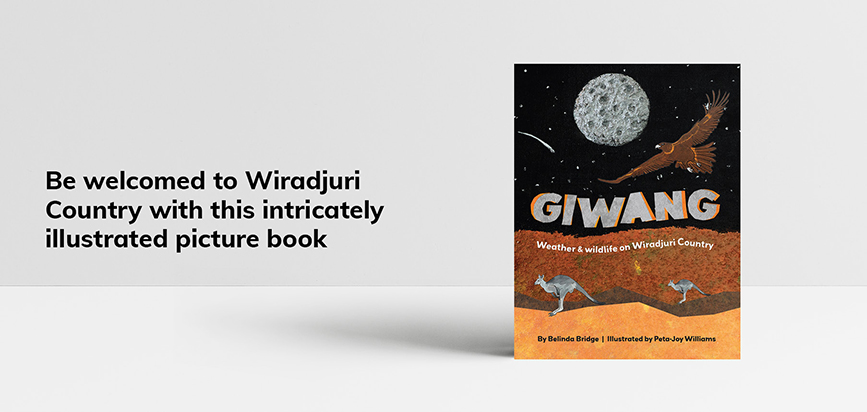Wiradjuri seasons explored in new picture book
giwang: Weather and wildlife on Wiradjuri Country, by Belinda Bridge and Peta-Joy Williams
The six weather cycles found on Wiradjuri Country are at the heart of a new picture book released by Aboriginal Studies Press. The six weather cycles found on Wiradjuri Country are at the heart of a new picture book released by Aboriginal Studies Press.
Written by Wiradjuri language teacher Belinda Bridge and illustrated by Wiradjuri artist Peta-Joy Williams, giwang: Weather and wildlife on Wiradjuri Country is a vibrant celebration of culture, language and environment. Featuring animals found on Wiradjuri Country, giwang is a visual feast for children aged 3 and up, while its language component offers something for readers of all ages.
Set in the central and south-west regions of New South Wales, the book explores wildlife through the lens of six traditional Wiradjuri weather cycles. Belinda Bridge thoughtfully compares these cycles with the western calendar, offering readers a deeper understanding of Wiradjuri ways of observing, interpreting and engaging with the natural world.
The richly detailed illustrations by Peta-Joy Williams bring the story to life. An experienced muralist and weaver, Williams embraced the challenge of illustrating her first book, incorporating elements from Wiradjuri Country into her artwork. Sand from Wambuul (Macquarie River) and water from both the river and Goan waterhole near Trangie were mixed into the paint, grounding the illustrations in place and story.
Governed by the phases of the moon, the Wiradjuri cycles reflect what Belinda describes as “rolling movements interrupted and determined by seasonal changes”. These cycles are shaped by weather patterns such as rain, which floods rivers and towns, transforming dry, cracked land into lush greenery.
In giwang, readers discover how these patterns – fire, flood and drought – interact to drive change in the environment, impacting both Wiradjuri People and the animals that live on Country. For example, wugil (hot and windy) may be followed by galing-galing bu niganaga ganhang-girri (wet and hot becoming warm), then ganhang-girri (becoming warm) and back to wugil – a dynamic rhythm of change.
Wildlife illustrations highlight animals likely to be active during each cycle, rendered in Peta-Joy’s deft and detailed style. Her paintings not only depict the animals but also embody the textures and spirit of Wiradjuri Country.
Published by Aboriginal Studies Press, giwang will be released on 1 November 2025. Find it at all good bookstores and through the AIATSIS Shop.
Release date: 1 November 2025
Publisher: Aboriginal Studies Press
RRP: $24.95 | 32pp | Paperback
Preorder: shop.aiatsis.gov.au
- END -
Media assets available here:
- Information sheet with key details about giwang.
- Book cover image and select page spreads.
- Author and illustrator pics.
Media enquiries
Aboriginal Studies Press
Email media enquiries to asp@aiatsis.gov.au
+61 2 6129 3934
9 am to 5 pm, Monday to Friday
Website: Aboriginal Studies Press
Facebook: @aiatsis
Instagram: @aiatsis
About the author
Belinda Bridge is a proud Wiradjuri woman who lives in Western Sydney, with strong matriarchal lines across Wiradjuri Country. She is a lover of story, and a mother, always learning more of her Language and Culture. As a teacher, Belinda shares that knowledge, teaching Wiradjuri language at TAFE and across all age groups. She has a degree in creative writing and professional writing, and a postgraduate qualification in Wiradjuri language, heritage and culture. Belinda’s inspiration to learn and speak Wiradjuri language comes from her family and a deep desire to stay connected to her ancestors.
About the illustrator
Peta-Joy (PJ) Williams is a proud Wiradjuri yinaa (woman) born in Sydney whose identity bridges the inland rivers of her ancestors and the saltwater cultures of the place she calls home. Drawing inspiration from both, PJ creates artwork that reflects the richness and diversity of her ancestry.
Encouraged by her Wiradjuri grandmother, Eileen, she began painting Aboriginal art early in life and has since formalised her practice with a Certificate IV in Aboriginal Art and Cultural Practices and a Diploma in Fine Arts. Formerly a cultural arts teacher, PJ is now a full-time artist and the founder of Wiradjuri Wave.
Her work has been exhibited in major galleries across Australia, and her large-scale murals feature throughout New South Wales.
